
Online notices from two Chinese universities announced new restrictions by Communist authorities on academic research on the origins of the coronavirus.
The notices have since been removed but a copy has been saved on Cached, according to CNN’s updated report on April 16.
Under the new restrictions, all research papers on the new coronavirus disease (COVID-19)will be subject to extra vetting. Studies on the origin of the virus will be closely scrutinized and must be approved by the central government, said the notices.
“Academic papers on the traceability of the new coronavirus must be reviewed by the academic committee of the school before publication, focusing on the authenticity of the paper and whether it is suitable for publication,” said the post of the China University of Geoscience in Wuhan. “After the review is passed, the school reports to the Ministry of Science and Technology, which can only be published after the review by the (ministry).”
Fudan University reportedly also posted a similar notice that was shortly taken down, too.
Earlier, US China expert and author Steven Mosher had reported that a research paper by Botao Xiao and Lei Xiao of the South China University of Technology on “The Possible Origins of the 2019-nCov coronavirus,” published last February on Research Gate had disappeared.
The research reportedly disagreed with the initial claim of the Chinese authorities the virus had come from the bats being sold at Wuhan wet market, and instead pointed to the intermediate horseshoe bats that were being studied by two Wuhan microlabs doing research on coronavirus.
“In summary . . . the killer coronavirus probably originated from a laboratory in Wuhan,” concluded the researchers.
“The paper was quickly censored by the Chinese authorities and disappeared online,” wrote Mosher in his blog on Life Site. “ . . . Deepening the suspicion of a cover-up, Chinese officials not only refused to provide samples of the China coronavirus strains to US researchers, it ordered private labs in China to destroy their samples and gene sequencing data. Were they afraid that researchers might find out that the pandemic was in fact caused by a virus that had been isolated at one of China’s research labs? It certainly looks that way.”
An internationally renowned if controversial social scientist and expert on Chinese demography, Mosher contested the “puzzlingly low” official death toll in China.
In his Life Site blog on April 6, Mosher said he had come up with “metrics” to show that the official death toll of some 3,800 and only 325 “confirmed cases” in Wuhan City, epicenter of Covid-19, were “false data.”
Mosher said that Wuhan has seven mortuaries with a total of 84 ovens that cremated the deaths due to COVID-19.
Assuming that cremation takes two hours, he continued, the ovens could have cremated 1,008 corpses each day for two months, which means, minus the number of non-COVID-19 deaths, “an estimated number of deaths from the Wuhan coronavirus of 50,000.”
He said another estimate would come from the “huge numbers of funeral urns being handed out.”
Mosher said Chinese authorities on March 23 announced that kin of the deceased should pick up the ashes until April 4, a Chinese memorial for ancestors.
“Investigative journalists from Caixin reported that funeral urns were being distributed at a rate of 500 a day at Wuhan’s seven mortuaries, meaning that a total of 3,500 urns were being handed out each day,” Mosher wrote. “Given that the window for picking up the urns was 12 days long, this would mean that 42,000 urns (were given out).”
On April 17, Beijing announced it was revising the “confirmed cases” in Wuhan from 325 to 50,333.
In addition, China, reported the South China Morning Post, “revised the coronavirus death toll in the city of Wuhan by more than 1,000 to 3,869, saying it was doing so to be ‘responsible to history, the people and the deceased.’”
“The previous fatality was 2,579,” the Post continued.
“(Beijing) also increased the number of confirmed cases by 325 to 50,333. This brings the overall death toll in China to over 4,600 and more than 83,000 cases.”
Mosher has written about Chinese revisionism and Communist censorship in his best-selling books “Hegemon: China’s Plan to Dominate Asia and the World” (Encounter Books, 2000; now on its fifth printing) and “Bully of Asia: Why China’s Dream is New Threat to World Order” (Regnery Publishing, 2017).
In “Hegemon,” Mosher argues that the Quin dynasty (2 BC) employed Legalism that made the entire population accountable directly to the emperor, and not the other way around, “(thus becoming) the archetype of a political monster that has become all too common in our modern age.”
In “Bully of Asia,” Mosher describes China under the Quin Dynasty as “the world’s first totalitarian state.”
The “latest iteration” of China’s Machiavellian Legalist heritage and its hegemonic and imperialist pretensions is the Chinese Communist Party (CCP), he writes in “Bully.”
“(The CCP continues) the autocratic tradition of the imperial Chinese state by . . . engaging in political practices familiar from dynastic times such as censorship, large-scale persecutions, purges, court intrigues and elite factional conflicts,” as well as “regarding the people as its property, as subjects rather than citizens.” INQ















































